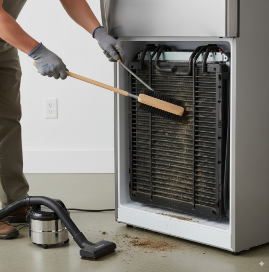
The Ultimate Guide to Cleaning Your Refrigerator’s Condenser Coils
Why Cleaning Refrigerator Coils Matters
Your refrigerator’s condenser coils are essential for heat dissipation that keeps food cold. When dirty, dust and debris block heat transfer, causing your compressor to work harder. This inefficiency inflates energy bills by up to 35%, strains appliance components, and causes inconsistent cooling.
Cleaning coils regularly is a simple maintenance task that can lower energy costs, extend refrigerator life, and enhance cooling performance.
Locating Your Refrigerator’s Coils
Coil locations vary by model:
- Bottom-mounted: beneath the refrigerator behind a removable grille or kickplate (most common).
- Back-mounted: on the rear panel, requiring moving the refrigerator for access.
- Top-mounted: rare in very old models, sometimes requiring panel removal.
Check your appliance manual or online resources to confirm coil location before cleaning.
Essential Tools for Professional-Quality Cleaning
- Refrigerator Coil Brush: Long, flexible brush designed to fit between coil spaces.
- Vacuum Cleaner with Brush Attachment: Soft brush prevents coil damage while removing dust.
- Screwdrivers: For removing grille or access panels.
- Helpful Extras: Flashlight, dust mask, microfiber cloths, drop cloths, and optionally compressed air.
Step-by-Step Guide to Cleaning Coils
Unplug the Refrigerator: Always disconnect power to prevent electrical hazards.
Access the Coils: Remove kickplate or grille for bottom coils; pull refrigerator out and remove rear panel for back coils.
Vacuum Dust: Use vacuum with brush attachment to gently suck dust from coils and surrounding area.
Brush Coil Fins: Carefully use the coil brush to dislodge remaining debris between coil rows.
Final Vacuum and Clean Surroundings: Capture loosened dirt, wipe down area, and clean grille thoroughly.
Reassemble and Power On: Refit all panels and plugs, then monitor the refrigerator for proper operation.
How Often Should You Clean Your Coils?
For most households, cleaning coils every 6 to 12 months is sufficient. However, increase frequency to every 3-4 months if you have pets, live in dusty areas, or have a heavy appliance usage.
Commercial environments or older refrigerators may require monthly cleanings to maintain optimal performance.
Watch for signs like frequent running, higher electric bills, inconsistent cooling, or visible dust buildup to determine if cleaning is needed sooner.
Benefits of Clean Refrigerator Coils
- Reduced Energy Consumption: Save up to 35% on electric bills by improving coil efficiency.
- Extended Appliance Lifespan: Lower strain on the compressor and parts means fewer breakdowns and longer fridge life.
- Improved Cooling Performance: Stable and consistent temperatures preserve food freshness better.
- Environmental Impact: Lower energy use reduces carbon footprint and utility demand.
Troubleshooting Common Coil Cleaning Issues
- Coils appear clean but fridge still runs often: Inspect door seals, thermostat, and internal airflow.
- Hard-to-reach coil areas: Use flexible coil brushes or consider professional assistance.
- Bent or damaged fins: Carefully straighten with a fin comb or seek technician help.
- Dust returns quickly: Improve home air quality, ventilation, and pet grooming routines.
DIY vs Professional Coil Cleaning
DIY coil cleaning is suitable if coils are accessible and dust is light. Use the proper tools and follow safety protocols.
Professional cleaning is advised for sealed or hard-to-access coils, damaged parts, suspected refrigerant leaks, or when warranties require expert service. Professional jobs typically cost $75-$150 but include complete inspections.
Seasonal Maintenance and Modern Fridge Considerations
- Spring & Fall: Schedule biannual coil cleanings and check door gaskets and temperature settings.
- Summer: Maintain clear airflow space and monitor for longer running times, signaling cleaning needs.
- Winter: Monitor dry air increases dust buildup; ensure humidity levels don’t affect operation.
- Smart & Energy Star Models: Even efficient models benefit from coil cleaning; some offer alerts for maintenance.
- Sealed Coil Systems: Require professional cleaning every 2-3 years for best performance.
Summary: Small Task, Big Impact
Cleaning your refrigerator’s condenser coils is a quick, affordable maintenance task that yields major benefits: up to 35% lower energy use, hundreds of dollars saved, better cooling, and extended appliance life. Whether doing it yourself or hiring a professional, regular coil cleaning is essential for an efficient, long-lasting refrigerator. Mark your calendar and keep your coils clean to protect your investment and save energy year-round.
Frequently Asked Questions
Q1: How can I tell if my refrigerator coils need cleaning?
Q2: Can I use compressed air to clean coils?
Q3: How long does coil cleaning usually take?
Q4: Is coil cleaning safe to do myself?
Check us out for more at OneSourceApplianceParts.com
